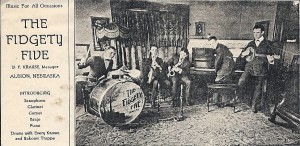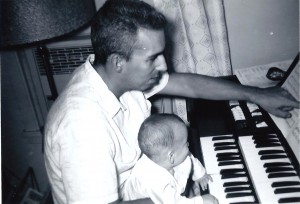Music has been an important part of our family for as long as anyone can remember. Below is an overview of the many currents that came together to shape the music I produce.
On the left is a wooden flute that traveled here with the Hosfords in a covered wagon in the early 1870s. Old newspaper articles recount how my great-great-grandparents, William & Alice Hosford, began holding musicales and giving music lessons as soon as their sod house was completed.
My great-grandfather, Oliver Hosford, played both violin and snare drum, and sat in with the band of every circus that passed through this area.
My grandfather, Russell, was a young man during the Jazz Age of the 1920s. He’s pictured below, while still in high school, playing banjo in probably the first jazz band in this area, The Fidgety Five. Though his first love was singing, he played banjo, ukulele, 4-string guitar and the rattle bones.
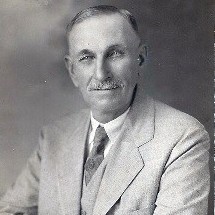 On the Mansfield side of my family, my great-grandfather Frank Mansfield loved playing the piano. Unfortunately, the few times the family tried to record him he became too nervous to play. My father, Frank’s grandson, said that though his grandfather didn’t play jazz, the older, dynamic style of piano his generation played contributed a lot to the development of jazz.
On the Mansfield side of my family, my great-grandfather Frank Mansfield loved playing the piano. Unfortunately, the few times the family tried to record him he became too nervous to play. My father, Frank’s grandson, said that though his grandfather didn’t play jazz, the older, dynamic style of piano his generation played contributed a lot to the development of jazz.
My mother Mari’s uncle, Richard Mansfield, played an important role in my own musical development. Uncle Richard grew up on a farm a few miles outside of Albion and rode a horse to and from school. The only instrument he could carry conveniently on his horse was a flute, so he ordered one through the mail and joined the school band. In time he also took up the tenor saxophone and clarinet.
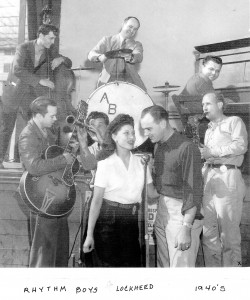 Richard played with local bands before joining the Nebraska Prison Band. Since there weren’t enough musically accomplished inmates to make up a full band, many of the musicians were hired from the outside world. Everyone wore prison stripes during their performances, and Richard toured with this band until someone stole his saxophone.
Richard played with local bands before joining the Nebraska Prison Band. Since there weren’t enough musically accomplished inmates to make up a full band, many of the musicians were hired from the outside world. Everyone wore prison stripes during their performances, and Richard toured with this band until someone stole his saxophone.
In the late 1930s Richard moved to California where he studied saxophone in Hollywood. Though he worked for Lockheed Aircraft during the day, his first love was always music. Richard practiced every evening and continued to play on weekends with various groups for many years to come (Richard is playing the tenor sax in this photo).
Richard and his wife Ruth paid their final visit to Albion when I was a sophomore in high school. And because it was easy to travel with, Richard brought his flute. We held jam sessions every night for a week. Richard played flute, my father Frank played piano, my grandfather Russ kept time on a cymbal, and I played my fingers raw on string bass.
This was the first time I’d ever played with a jazz musician other than my father, and it still ranks as one of the best weeks of my life.
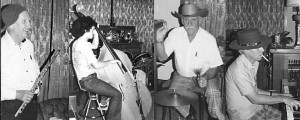 When it came time for Richard and Ruth to return to California, Richard handed me his flute and said – despite the fact I was already learning both guitar and bass — “Here, learn to play it.” I’ve been working on it ever since and was pleased when my daughter, Angela, chose flute when she started band in the fifth grade.
When it came time for Richard and Ruth to return to California, Richard handed me his flute and said – despite the fact I was already learning both guitar and bass — “Here, learn to play it.” I’ve been working on it ever since and was pleased when my daughter, Angela, chose flute when she started band in the fifth grade.
![]() My father Frank began taking piano lessons at the age of 5, and it was an hour of practice every day for the next ten years. He’d do anything to get out of it only to have to practice twice as long the next day if he did.
My father Frank began taking piano lessons at the age of 5, and it was an hour of practice every day for the next ten years. He’d do anything to get out of it only to have to practice twice as long the next day if he did.
Frank didn’t much care for performing either, maybe because he was regularly hauled out of bed to play for late evening visitors. But as he got older he began playing the music he liked – jazz – and suddenly all those lessons began to pay off. In high school he was known as “Eighty-Eight Keys Frank.”
![]() Frank enlisted in the Navy the day he turned 18 in March of 1945 and was classified as a musician. However, Navy musicians were officially there only to play during parades. So since pianos are notoriously hard to march with, my dad was listed as a baritone horn player. He once said he lived in constant fear of being called upon to actually play the baritone sometime.
Frank enlisted in the Navy the day he turned 18 in March of 1945 and was classified as a musician. However, Navy musicians were officially there only to play during parades. So since pianos are notoriously hard to march with, my dad was listed as a baritone horn player. He once said he lived in constant fear of being called upon to actually play the baritone sometime.
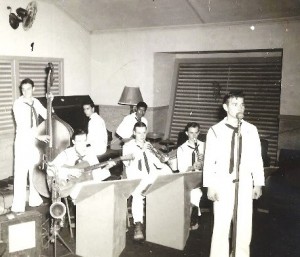 Fortunately, he wasn’t. Sailors love music as much as everyone else, and after boot camp he was assigned to play piano with a big band. This was when he discovered how much he hadn’t learned from lessons with his aunt, Methodist organist Ora Hutchinson. Instead of written-out piano parts, all he had were “charts” full of arcane chord symbols. And none of them were chords he knew!
Fortunately, he wasn’t. Sailors love music as much as everyone else, and after boot camp he was assigned to play piano with a big band. This was when he discovered how much he hadn’t learned from lessons with his aunt, Methodist organist Ora Hutchinson. Instead of written-out piano parts, all he had were “charts” full of arcane chord symbols. And none of them were chords he knew!
It was a classic “sink-or-swim” situation (no naval pun intended). Since he couldn’t read the charts, he had to rely on his ear and innate musical skill. Fortunately that worked and he went on to play with many fine musicians, especially while stationed in the Philippines.
Frank planned to continue playing when he got out of the service, but events in a Harlem nightclub, Minton’s Playhouse, changed his (and many other people’s) musical future. There, legendary musicians like Dizzy Gillespie, Charlie Parker and Thelonious Monk had invented a new style of jazz, a frantic, harmonically complex approach they called “Be Bop.”
Be Bop was so new and different that it was initially believed you could only play it while high on heroine. So when back in the States and faced with adapting to a new and unfamiliar musical style and thinking he would have to start taking drugs in order to play it, Frank instead came home where he continued to play for friends and family but rarely for the public.
Music remained an important part of Frank’s life, though, and when I came along he wasted no time in introducing me to it. I can’t have been more than six months old in this photo, and while I probably didn’t retain much from this first lesson, I could play C Jam Blues and Sentimental Journey by the time I started school.
Though he no longer worked as a musician, Frank never lost his love of jazz. He amassed a remarkable record collection and taught himself to play in a number of different styles, including those of George Shearing, Thelonius Monk, Lenny Tristano and Dave Brubeck. When I was eleven I started listening to his records and soon found there was something about the freedom and creativity of jazz that made me want to play it too.
Inspired by a bass guitar solo Arvell Shaw played during a televised tribute to the recently-deceased Louis Armstrong, I badgered my father into buying me a used bass guitar (it had a Budweiser label taped to it that my mother Mari made me remove as soon as we brought it home). Frank taught me the notes and how to play the more common scales. He then wrote out simple two-beat bass parts for jazz standards like Paper Moon, Satin Doll and Sweet Lorraine. Not having time to write out any more bass parts, he started just playing songs and I had to figure out what to play. I wasn’t any good at it but I loved trying and we played whenever time permitted. (I asked him years later how he managed to tolerate my terrible playing; he replied that he could “hear what was to come…”)
A year later my parents bought me a used guitar and Frank began 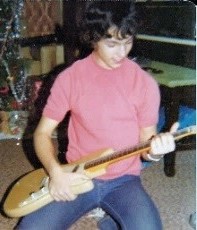 teaching me chords. In time I began to wonder what it would sound like if the bass and guitar played together. We had a couple of tape recorders around the house so I started recording bass parts. I would then play these parts back while playing along on guitar or piano and record the result on the second machine. Over time I acquired better and better recording equipment and even began building electronic devices (often using old radio tubes) to improve the quality of my sound. When I was 15 I turned my closet into a tiny recording studio and began composing and playing in earnest.
teaching me chords. In time I began to wonder what it would sound like if the bass and guitar played together. We had a couple of tape recorders around the house so I started recording bass parts. I would then play these parts back while playing along on guitar or piano and record the result on the second machine. Over time I acquired better and better recording equipment and even began building electronic devices (often using old radio tubes) to improve the quality of my sound. When I was 15 I turned my closet into a tiny recording studio and began composing and playing in earnest.
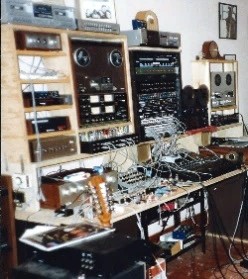 My studio grew with time and in 1986, a year after Lori and I were married, we moved into a house with a large upstairs room that provided enough space to record not just my projects but groups as well (because the attic was full of bats, we named this studio “The Bat’s Nest”). We started an actual business which enabled me to generate some income from my equipment investment, and over the next few years I recorded a rock band, a church choir and several solo artists. It also gave me a chance to develop my playing, composing and engineering skills.
My studio grew with time and in 1986, a year after Lori and I were married, we moved into a house with a large upstairs room that provided enough space to record not just my projects but groups as well (because the attic was full of bats, we named this studio “The Bat’s Nest”). We started an actual business which enabled me to generate some income from my equipment investment, and over the next few years I recorded a rock band, a church choir and several solo artists. It also gave me a chance to develop my playing, composing and engineering skills.
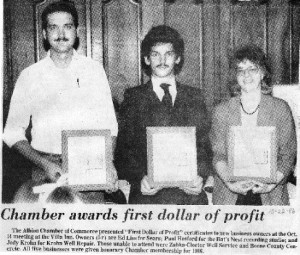 Our first child, William, was born in 1991. I would try to record when he was asleep, putting the baby monitor next to my mixing board. But with Lori teaching school I was his full-time caregiver, and by the time Angela came along two years later, there was no time to do anything musical. We moved to a different home, and my equipment was stored in a back bedroom where it remained untouched for several years. By the time our son, William, was 5, I hadn’t played in years.
Our first child, William, was born in 1991. I would try to record when he was asleep, putting the baby monitor next to my mixing board. But with Lori teaching school I was his full-time caregiver, and by the time Angela came along two years later, there was no time to do anything musical. We moved to a different home, and my equipment was stored in a back bedroom where it remained untouched for several years. By the time our son, William, was 5, I hadn’t played in years.
One day when we were out of town I noticed a used guitar in a pawn shop window and we went in so I could try it out. I was rusty but did remember a couple of tunes. As I was playing I glanced up to see William staring in amazement. His eyes were wide and his mouth was open. I stopped playing and he said, “Daddy, I didn’t know you could play guitar – it works!”
I didn’t buy that guitar but I felt guilty that my own children didn’t know I was a musician. A week later Lori cajoled me into buying a new guitar. I hated to spend the money, but I ended up playing it every day for the next three years. Several friends urged me to record my playing but to do so I had to build a new recording studio in our basement. This took some time but it gave me the opportunity to improve my studio design and layout. I also invested in a new digital recorder that enabled me to do much more than I had ever been able to do with reel-to-reel recording tape.
The technology available when I returned to recording not only allowed me to do much more in the studio than I’d been able to do in the past, it also made it possible for me to produce my own CDs. This led Lori and me to starting an Internet-based record label, Painted Heart Music, in the early 2000s.
My son Thomas’ story has just begun to be written – he had only 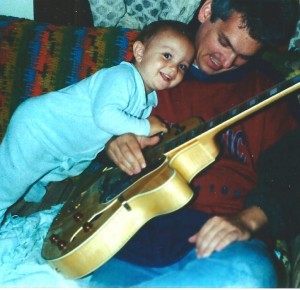 been 16 years old for a few weeks at the time of this writing. But Thomas has always loved music. When he was very young he’d sing and sing. Life was an ongoing opera for Thomas – he would sing about what he was doing all the time.
been 16 years old for a few weeks at the time of this writing. But Thomas has always loved music. When he was very young he’d sing and sing. Life was an ongoing opera for Thomas – he would sing about what he was doing all the time.
The day he turned five Thomas asked if he could start piano lessons. Lori and I were hesitant to send him to lessons before he’d even started school, but he embraced the piano with a passion neither his mother nor I had had when we were young and learning to play.
The summer before he started eighth grade Thomas asked me “if we could talk.” I had no idea what was coming but Thomas, who had been going with me to the nursing home to help me record Frank, said he’d like to play the vibraphone with his grandfather and me.
Vibraphones (“vibes”), though, are hard to find; we initially borrowed one from the local school. It needed several repairs but we finally got it working. We had to remove two doors in order to get it into my basement studio, but Thomas, who was already familiar with playing mallets, had little trouble getting on to the rhythms and accents that go with playing jazz.
In time, though, the school needed its vibraphone back. This brought our recording project to a prolonged halt while we searched for another instrument. After finding several that we couldn’t afford, I put out feelers among musicians I know and waited for something to develop.
Lori and I are co-directors of the local Arts Council, an organization that presents a variety of concerts each year. While dining with two of our visiting artists, 14-string guitarist Joe Scott and his wife, cellist Hannah Alkire – who together form the amazing duo Acoustic Eidolon – I explained our situation to them. Hannah immediately spoke up, saying that her father Richard had a set. She said she’d see if he might be interested in selling them to a promising beginning player.
Hannah’s father soon got in touch with me and we arranged to visit him in Champagne, Illinois, “in the house with the roses on the mail- box.” Richard had had his set of vibes since the early 1960s when he’d studied with vibes master Terry Gibbs in New York City, and I wasn’t sure if he really wanted to part with it. Every musical instrument has its own personality and in time becomes an extension of its owner. But Richard seemed to understand that Thomas was serious about playing the vibes, and he took the opportunity to “pass the torch” to a new generation.
As soon as Thomas’ eighth grade year was finished we headed for 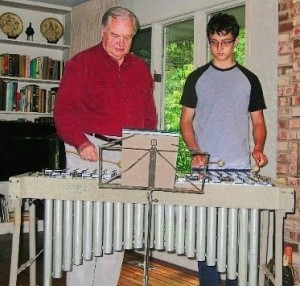 Champagne. After 600 miles on the road Richard met Thomas at the door by saying “Welcome to the beginning of your new life!” The vibes sat glistening in the middle of a room surrounded by a harpsichord, two vintage Gibson guitars, lots of sheet music and CDs, and a Bosendorfer grand piano.
Champagne. After 600 miles on the road Richard met Thomas at the door by saying “Welcome to the beginning of your new life!” The vibes sat glistening in the middle of a room surrounded by a harpsichord, two vintage Gibson guitars, lots of sheet music and CDs, and a Bosendorfer grand piano.
Richard proved to be a remarkable man in many ways – talented, warm, intelligent, and kind. And our visit was very much a “passing of the torch.” Richard not only sold us his beloved instrument (he told it goodbye before we left), he took a lot of time teaching Thomas how to improvise the blues. Thomas’ life won’t ever be the same, and Lori and I will be forever grateful for the time, care and patience Richard showed him. Meeting Richard was a wonderful experience and what he said when we arrived proved to be right – it was the beginning of Thomas’ new life in music.
Since then Thomas has expanded his musical instrument “menagerie” to include not just vibes and drums but the bass guitar and the ukulele as well. I look forward to what music will bring to Thomas and his siblings’ lives and hope that one day they will pass our family’s musical legacy on to the generations yet to come.
Lori and I met Rich in the summer of 1985 when we stopped by a music store in Grand Island and were met by some of the best chord-melody guitar playing I had ever heard. I introduced myself to the gentleman playing it and Rich and I proceeded to have a nice conversation. I invited him to visit Frank and me in Albion and we’ve been friends ever since. Rich is not only an excellent musician, he’s one of the finest people I’ve ever known.
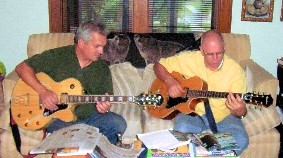 I learned a lot about playing guitar from Rich, and I recorded all the guitar parts for Generations on an Epiphone Zephyr Regent that he passed on to me back in 2003.
I learned a lot about playing guitar from Rich, and I recorded all the guitar parts for Generations on an Epiphone Zephyr Regent that he passed on to me back in 2003.
A graduate of Nebraska Wesleyan University in Lincoln, Rich taught band for 37 years until his retirement in 2006. Rich played trumpet on weekends for 17 years with The Bobby Layne Orchestra and then played guitar for 27 years, first with the band Oak Creek and then with Mohana with Red Shoes. Rich has also performed at retirement homes around the area.
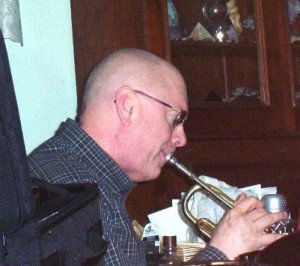 Rich has appeared on several Painted Heart CDs playing both guitar and trumpet, and he did all the trumpet/flute arrangements on Melissa Casper’s CD, When I Fall in Love. I’ve got several more recordings of Frank that I want to add Rich to on trumpet, and I’m hoping someday to do a full CD featuring him.
Rich has appeared on several Painted Heart CDs playing both guitar and trumpet, and he did all the trumpet/flute arrangements on Melissa Casper’s CD, When I Fall in Love. I’ve got several more recordings of Frank that I want to add Rich to on trumpet, and I’m hoping someday to do a full CD featuring him.
